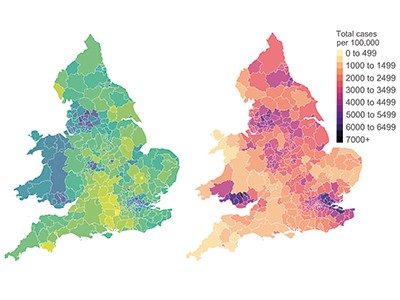Contact-tracing App Curbed Spread of COVID in England and Wales
Contact-tracing App Curbed Spread of COVID in England and Wales
SHP's Jason Wang writes in this Nature article that digital contact tracing has the potential to limit the spread of COVID-19.

The idea behind digital contact tracing is that, when an individual tests positive for an infectious disease such as COVID-19, an app on their smartphone can send a notification to other smartphones that have been in close proximity, such as within 2 metres, for more than a certain period of time, say 15 minutes. However, such apps can be difficult for people living in a democracy to accept because of concerns about data privacy. Writing in Nature, researchers demonstrate effective implementation of a digital contact-tracing app on a large scale in a democratic society: England and Wales in the United Kingdom.
Read the paper: The epidemiological impact of the NHS COVID-19 App
The technology used in the app, which was named the NHS COVID-19 app after Britain’s National Health Service, is the Google Apple Exposure Notification (GAEN) system. This uses low-energy Bluetooth-enabled radio signals to send a randomly generated identification code from one phone to another that is in close proximity, creating a sort of ‘handshake’; these codes change every 10–20 minutes. The codes of phones that have been in close physical contact over the previous 14 days are stored in the app on a user’s phone. When a user tests positive for COVID-19, they can consent to have their codes sent anonymously to a central server. Other app users can sync with the central server for a match. Thus, the app can help to alert people who have potentially been exposed to COVID-19, so that they can then get tested, voluntarily place themselves in quarantine and inform their contacts that they should do the same.
A contact-tracing app will make a meaningful difference in the population only if a large enough proportion install and use it. The NHS COVID-19 app experience shows that there is enough participation in app use for it to be useful. An estimated 33.9 million people were eligible to download the app (that is, they were aged 16 or over, were located in England or Wales and had a compatible smartphone). Between its launch on 24 September 2020 and the end of 2020, the app was downloaded on 21 million separate devices and, between 1 November and 11 December 2020, it was regularly used by an average of about 16.5 million users, which is about 49% of the eligible population, or 28% of the total population of England and Wales. Moreover, 72% of app-using ‘index’ cases (individuals who tested positive for COVID-19) consented to an app-based exposure notification being sent after testing positive.





